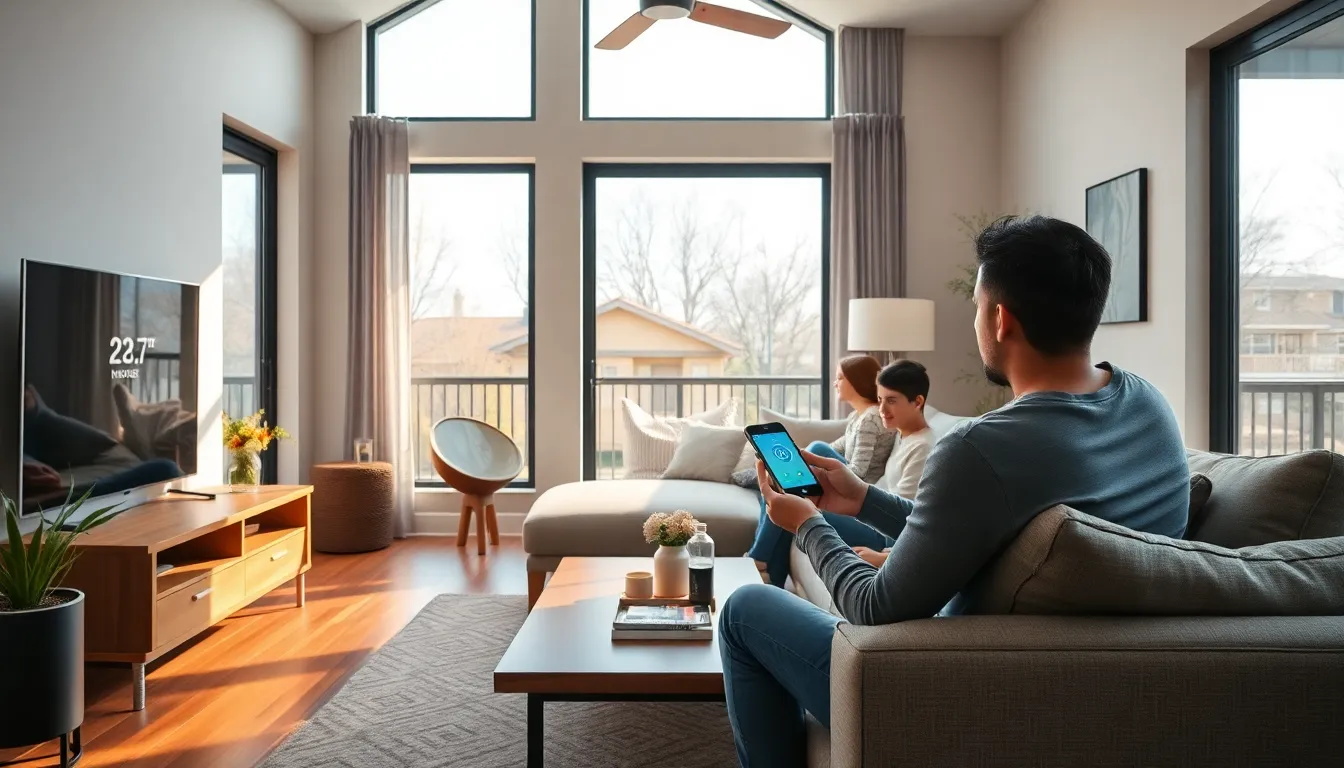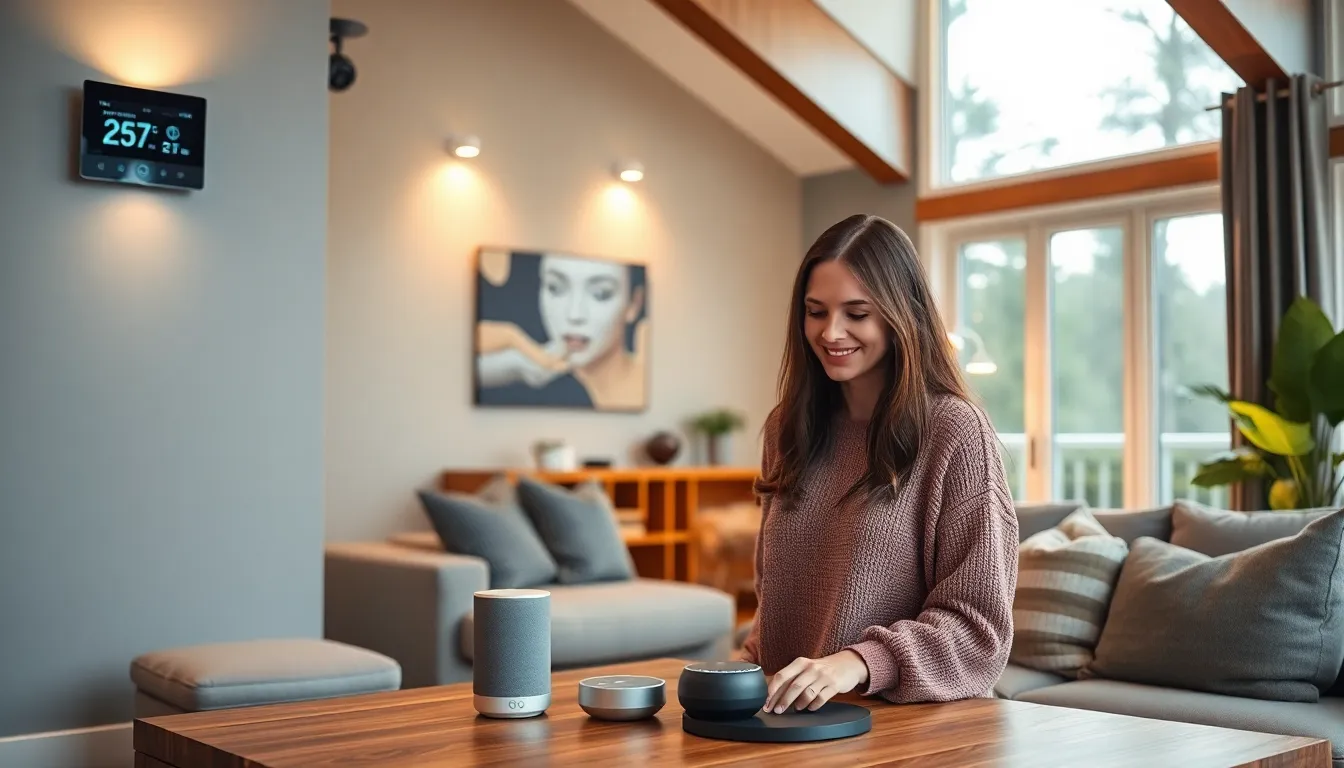In today’s fast-paced world, connected living spaces are transforming how people interact with their homes. These innovative environments seamlessly integrate technology to enhance comfort, security, and convenience, creating a lifestyle that caters to the modern individual’s needs. Imagine controlling lighting, temperature, and security systems with just a voice command or a tap on your smartphone.
As smart devices become increasingly prevalent, the concept of connected living spaces is no longer a futuristic dream; it’s a reality that many embrace. From smart thermostats that learn user preferences to advanced security systems that provide peace of mind, these interconnected solutions are redefining what it means to live in harmony with technology. This article explores the evolution, benefits, and potential of connected living spaces, offering insights into how they can enrich daily life.
Table of Contents
ToggleOverview of Connected Living Spaces
Connected living spaces utilize technology to create smarter, more efficient environments. These spaces incorporate a range of smart devices and systems designed to enhance comfort, improve security, and provide convenience. Smart thermostats, lighting controls, and integrated security systems are just a few examples of devices that work together seamlessly.
Key Components
- Smart Devices: Include gadgets like smart speakers, bulbs, and refrigerators that connect to the internet.
- Home Automation Systems: Allow users to control multiple devices through a single application or voice commands.
- IoT Integration: Internet of Things (IoT) technology connects devices, enabling communication among them for enhanced functionality.
Benefits
- Enhanced Security: Security cameras and motion sensors provide real-time monitoring and alerts.
- Energy Efficiency: Smart thermostats and lights optimize usage, reducing energy costs.
- Improved Comfort: Automation features adjust settings based on user preferences, offering personalized living experiences.
Future Potential
Connected living spaces are evolving rapidly. Advances in artificial intelligence and machine learning will enable more adaptive and responsive environments. Emerging technologies promise even greater integration, making daily activities effortless and enhancing overall quality of life.
Benefits of Connected Living Spaces

Connected living spaces offer numerous advantages that significantly enhance the quality of life for residents. These benefits arise from the integration of smart technology designed to improve functionality, safety, and efficiency within homes.
Enhanced Comfort and Convenience
Enhanced comfort and convenience stem from personalized automation and smart home devices. Individuals can control lighting, temperature, security systems, and entertainment options from mobile devices. Programmable thermostats automatically adjust heating and cooling based on occupancy and preferences, ensuring optimal comfort throughout the day. Voice-activated systems provide hands-free management, allowing residents to execute tasks effortlessly. For example, smart speakers can control multiple devices, enabling users to customize their environment with simple verbal commands.
Energy Efficiency and Sustainability
Energy efficiency and sustainability are crucial benefits of connected living spaces. Smart systems monitor and optimize energy consumption, which can lead to significant cost savings. For instance, smart thermostats reduce unnecessary heating and cooling by learning schedules and adapting accordingly. Additionally, energy-efficient appliances connected to the Internet of Things (IoT) can be programmed to operate during off-peak hours, minimizing energy usage and costs. Homes equipped with solar panels can also maximize energy efficiency by managing power generation and consumption in real-time, contributing to a more sustainable living environment.
Technology Behind Connected Living Spaces
Connected living spaces rely on advanced technology to create a seamless, integrated environment that enhances comfort, security, and efficiency. Key components include smart home devices and robust IoT integration.
Smart Home Devices
Smart home devices are essential in connected living spaces, enabling automation and remote control of various home functions. These devices range from smart thermostats and lighting systems to security cameras and voice-activated assistants. Each device offers unique features:
- Smart Thermostats: These devices learn user patterns to optimize heating and cooling, allowing for energy savings.
- Smart Lighting: Users can control brightness and colors remotely or through automation based on time or occupancy.
- Security Systems: Real-time monitoring and alert mechanisms enhance safety, with features such as motion detection and remote viewing.
- Voice Assistants: Voice-activated technology simplifies interaction with other smart devices, streamlining overall management of the living space.
Internet of Things (IoT) Integration
IoT integration is critical for enhancing the functionality and capability of connected living spaces. It involves the interconnection of various devices through the internet, allowing them to communicate and collaborate effectively. Key aspects include:
- Data Exchange: Devices share information, leading to improved decision-making, such as when to adjust heating based on occupancy.
- Remote Access: Homeowners can manage their devices from anywhere, providing convenience and peace of mind.
- Automation: The ability to set routines promotes efficiency, such as scheduling lights to turn on at sunset or appliances to run during off-peak hours.
- Energy Management: IoT systems monitor energy consumption, facilitating real-time adjustments that lead to reduced utility costs.
Together, smart home devices and IoT integration form the backbone of connected living spaces, transforming homes into intelligent environments that cater to the needs of their inhabitants.
Challenges and Considerations
Connected living spaces face various challenges and considerations that affect their implementation and user experience. Understanding these aspects is crucial for anyone looking to adopt or enhance smart home technology.
Security and Privacy Concerns
Security and privacy concerns dominate the challenges associated with connected living spaces. Data breaches and hacking threats expose sensitive personal information stored in smart devices and home networks.
- Insecure Devices: Many devices lack robust security features, making them vulnerable to cyberattacks.
- Data Collection: Continuous data collection by smart devices raises privacy concerns, as users may not know how their data is used or shared.
- Network Vulnerabilities: Weak home networks, often protected by outdated passwords, present entry points for unauthorized access.
- User Awareness: Users must actively monitor and manage device settings to maintain security, which requires a level of technical understanding many may not possess.
Addressing these concerns involves selecting devices from reputable manufacturers, employing strong passwords, and regularly updating software.
Technical Limitations
Technical limitations hinder the seamless integration of connected living spaces. Issues related to device compatibility and connectivity contribute to user frustration.
- Interoperability: Not all smart devices work well together due to differing standards and protocols, limiting functionality.
- Connectivity Issues: Reliance on Wi-Fi networks can result in slow or interrupted service, affecting device performance.
- Power Dependence: Many smart devices operate on electricity; a power outage can render them inoperable, disrupting the connected experience.
- Cost of Upgrades: Maintaining and upgrading systems can become financially burdensome, as technology evolves rapidly.
Overcoming these limitations often requires investing in compatible devices and a reliable internet connection to enhance the overall connected living experience.
Future Trends in Connected Living Spaces
Emerging trends in connected living spaces focus on advanced technology integration, enhanced user experiences, and improved sustainability. These trends shape the future of home environments, aligning with user demands for efficiency and convenience.
- Artificial Intelligence Integration
Artificial intelligence (AI) enhances the functionality of connected devices. AI learns behaviors to automate tasks, adjust settings, and optimize energy use based on user preferences. Smart assistants provide real-time assistance, controlling devices and managing schedules effortlessly.
- Seamless IoT Connectivity
Improved Internet of Things (IoT) connectivity facilitates better communication among devices. Advanced protocols, such as Matter, streamline interoperability across different products and brands. Enhanced connectivity ensures seamless coordination, allowing devices to work in harmony for optimized user experiences.
- Increased Energy Efficiency
Energy management systems in connected living spaces optimize energy consumption. Smart meters provide real-time feedback to homeowners, allowing adjustments that lead to cost savings. Homeowners can utilize energy data to reduce bills and promote sustainability by incorporating renewable energy sources.
- Health and Wellness Monitoring
Health-focused technologies gain traction in connected homes. Devices monitor air quality, humidity levels, and even personal health metrics. This data enables better decision-making regarding home environments and personal well-being, promoting healthier living spaces.
- Enhanced Security Features
Connected living spaces are embracing advanced security measures. Smart locks, surveillance systems, and home health monitoring share data to create comprehensive security solutions. Real-time alerts and remote monitoring offer peace of mind, reducing security risks.
- Energy Harvesting Technologies
Innovative energy harvesting technologies, such as solar panels and energy-generating materials, power connected devices sustainably. These advancements reduce dependence on the grid and enhance the self-sufficiency of connected living spaces.
- User-Centric Design
A growing focus on user-centric design improves usability in connected living spaces. Intuitive interfaces, voice control, and customizable settings ensure accessibility for all users. Designs prioritize functionality, aesthetics, and ease of use, enhancing overall satisfaction with smart home technology.
- Remote Work Solutions
With remote work becoming commonplace, connected living spaces prioritize integration of workspaces. Smart technology facilitates efficient multitasking and supports workspace productivity. Technologies such as noise-canceling systems and high-speed internet connectivity ensure optimal remote working conditions.
These trends collectively signify the evolution of connected living spaces, targeting enhanced user engagement, energy efficiency, and comfort. As technology continues to advance, connected homes will increasingly adapt to the changing needs and lifestyles of their inhabitants.
Connected living spaces are redefining how individuals interact with their homes. By integrating smart devices and advanced technology, these spaces enhance comfort, security, and energy efficiency. As innovations continue to emerge, the potential for even more adaptive and user-friendly environments grows.
While challenges such as security concerns and technical limitations exist, proactive measures can mitigate these risks. Embracing connected living not only simplifies daily routines but also promotes sustainability and wellness. As technology evolves, so will the opportunities for creating smarter and more responsive living environments that cater to modern needs.



